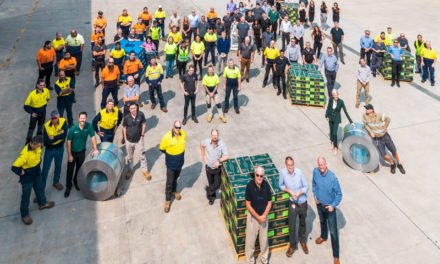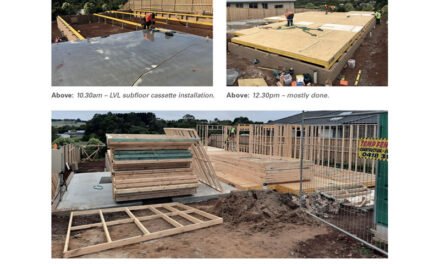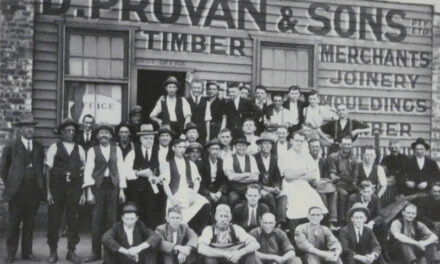Where timber is impracticable, TimberTech delivers the same look with zero splinters and little upkeep.
Heretical as this statement is, there are times when timber isn’t the best option. From wet or damp areas to sites where maintenance budgets need to be minimised, there are applications where a decking material other than timber is ideal.
TimberTech has built its business on this fact, at the same time as acknowledging the aesthetic appeal and popularity of timber decking. Their clever solution is PVC boards (and some composite solutions) that have an attractive timber-impersonating wrapping (known as capping) that gives the boards a convincingly natural appearance.
The best news? Choosing PVC doesn’t mean sacrificing environmental goals. “We’re the largest vertically integrated recycler of PVC in the US,” says Troy Cleyne, Australasia market manager for TimberTech. “We have three plants and take in plastic from multiple streams. Some of it is the American equivalent of kerbside recycling, some of it is our own plastic waste generated within the business and with leftover product that has come back from our customers and the rest comes from industry.
“Film wrap is actually the largest part of our recycling efforts in the US, which is great as there’s so much of it used in construction and related industries. It’s usually made of low-density polyethylene, which doesn’t have a lot of avenues for recycling, because most products made from recycled plastic use high-density polyethylene. But we can get the strength we need out of this product and take more plastic out of the waste stream.”
For the PVC product, the recycled content is around 50%, while for the composite boards it’s a whopping 80% including 100% for the reclaimed timber fibres that form part of the product’s core. As for the company itself, 99% of its internal scrap products are diverted into re-use, as is 97% of its water through an on-site filtration plant.
In the US, at the end of service life, customers can return their used boards to TimberTech and they go back into the process for the next batch of decking: Cleyne hopes that in the future this will be practicable in Australia, too.
MAKING LIFE EASY
Of course, markets aren’t really built on eco credentials, they’re built on money. And while TimberTech decking comes at a price fitting a premium product, there is a lot of money to be saved in the upkeep as it doesn’t require repeated coating in future years.
“We’ve seen a lot of commercial clients come on board,” Cleyne says. “Some of that is because we offer a longer warranty. While timber and composite boards might have five- or 10-year warranties, our PVC boards have a 20-year warranty.
“A big market for us is shopping centres. We did a large PVC decking area around the food court at Westfield Miranda. They were spending $11,000 a year oiling their decks and seats; now they just hose our product down. That’s all that’s needed.”
Big residential builders are also keen customers. “We sell a lot to Multiplex in Victoria and New South Wales,” says Cleyne. “They use it in many of their commercial applications for wet areas around swimming pools and for interiors where they’re wanting to save on maintenance. Although it’s a high-end product, the benefits that flow from minimal upkeep actually save them money.”
Almost all of these are applications where timber would be unsuitable or uneconomical, so TimberTech delivers a complementary rather than competing product. It’s one that respects its inspiration, spending a lot of research money and time on delivering true-to-life finishes. “I’ve had the Miranda centre management ring me to ask where their client can purchase the spotted gum we used in their deck. And I’ve had to say, it’s actually not spotted gum…” Cleyne says.
At the manufacturing plants in the US, there are significant scientific/R&D teams that are constantly developing better-looking and better-lasting finishes. While many polymer and composite boards are stamped/impregnated with a wood texture and colour pattern that repeats regularly, TimberTech PVC board has a brushed finish.
“It’s a matt finish with a shifting set of colour flecks that give the boards a timber grain, so it looks more natural,” says Cleyne. “Every decking board is different to the one that’s just been laid. The browns might be darker or there could be flecks and strokes of yellow or grey or other colours going through the finish. It’s really painterly and it gives it that genuine timber look.”
The finishes are so impressive that Cleyne has been selling product that isn’t even launched in the Australian market yet. “We have a new Landmark collection that resembles cross-cut timber and it will be arriving here in August, but we’ve already got so many orders on it. There’s one colour – French white oak – that has orders from both commercial and residential customers. It’s really exciting,” he says.
Cleyne makes a point of visiting architects and specifiers regularly, which is part of what he considers to be a real maturation in the decking industry. “A few decades ago, people were spending all their money on home theatres and big lounge rooms and the deck was an afterthought,” he says.
“Now, people are very serious about their outdoor living. They want the pizza oven, they want the outdoor kitchen and heaters so they can use the deck in winter. It’s had a real impact on the industry, including the recent formation of the Australian Deck & Handrail Association which I’m a part of.”
Cleyne notes that this new focus on decks has led to a general uptick in quality, as more carpenters focus on decking installation. “We’ve seen some really good carpenters say, ‘we’re not going to do general carpentry work anymore. We’re going to focus on being decking installers.’ Our biggest installer, who’s probably the most successful installer in Sydney and nearby, is called the Aussie Decking Chippie. He’s on social media, on Instagram, and he’s just enormous there. He’s got such a big following.”
Social media and reality shows on streaming services have also helped to popularise decking trends from larger markets, particularly the US. “People see what’s happening with different coloured ‘picture frames’ around the deck, patterns in the deck and so on,” Cleyne says.
“One of our big advantages is that many of those things are easier to do with PVC board. We’ve now got decking installers that have heated blankets they set up on the driveway and they heat these boards and bend them gently into circles and curves. There’s a beautiful job an installer did recently in Newcastle with a circular firepit and curved lines on the stairs. I’ve been showing these jobs to architects and they’re just blown away by the possibilities. And now they’re starting to design these lines into some of their applications.”
TECHNICAL DETAILS
Weighing at around 16kg per 6m length, the PVC boards are surprisingly robust. The main part of the board is the core which delivers the strength and stability, surrounded by capping, a thin film that carries the brushed timber finish and protects the core from UV damage and moisture.
“All our capping is a full enclosure,” says Cleyne. “Some companies do it on three sides only, to save money, but we do a complete wrap for several reasons. On the composite boards, it’s a vital part of keeping moisture out, because if you have any timber content and you add moisture, you will have expansion and contraction. On the PVC board, it protects the plastics in the core, which can become brittle if they’re exposed.
“Additionally, the all-round capping means you have a seamless, stronger surface, so it looks great for its whole service life.”
At such a light weight, the boards aren’t structural. They’re specified to be laid on a frame with maximum 400mm centres.
“We have a series of compatible fastening systems and any standard subframe will suit; treated pine, hardwood, steel – aluminium is becoming very popular,” Cleyne says.
“The one watchpoint is those 400mm centres, because some installers in Australia are used to using 450mm centres, the same as in house frames. But those give just a bit too much bounce in the deck, because the boards are flexible. We use the US standard of 400mm centres, which usually means one extra joist in a deck, and we’ve found that some installers now are using 380mm spans as a matter of course, because that gives them the most economical timber cutting.”
While TimberTech is a US product, the company has invested heavily in Australian testing to make sure it is suitable for local conditions. “We’ve had it tested at Warringtonfire, which was a significant investment,” says Cleyne. “It’s about $25,000 per test and we needed separate tests for each type of frame, but it has achieved a BAL 29 rating, which is the same as spotted gum and other high-end hardwoods.”
The board ranges have also been slip-tested at the CSIRO or Melbourne’s ATTAR and achieved a P5 slip rating, which is the best possible resistance to slipping.
“It’s a particular advantage for shopping centres and any commercial buildings with old or young people,” Cleyne says, “because that rating will satisfy their insurers. We had the Miranda centre management team call up after a woman had a slip there and when I sent him the P5 certificate, he was: ‘beautiful, we’re covered.’”
The PVC boards are also barefoot-friendly. “One issue I have with the wood-plastic composite is that in our summers, the boards get extremely hot,” says Cleyne. “If you have a typical summer in much of Australia with a run of 35 degree Celcius days, those boards can reach 60-65 degrees because they hold the heat. You can’t walk on them comfortably and they’re a risk to pets as well.
“The PVC boards disperse the heat immediately. In fact, on a hot summer day, these boards are up to 30% cooler than any other decking product, including timber. And with no risk of splinters and no need to spend a few days a year stripping, sanding and re-oiling.”
Cleyne laughs at this point. “Our marketing slogan is ‘Timbertech: everything wood should be’. Which is a cheeky thing to say to Timber Trader News readers. But it is the ideal product to fill applications where timber options won’t work, while keeping the look of wood.”
For more, visit www.timbertech.com.au
Image: The boards can be moulded into curves, as in this Newcastle residential garden.











